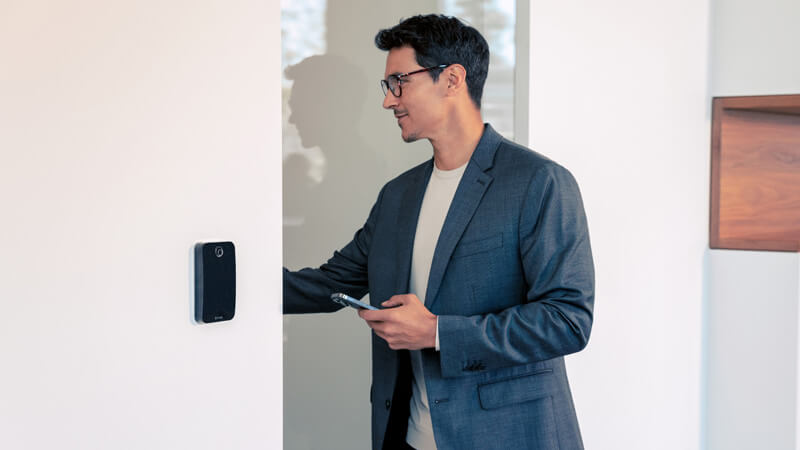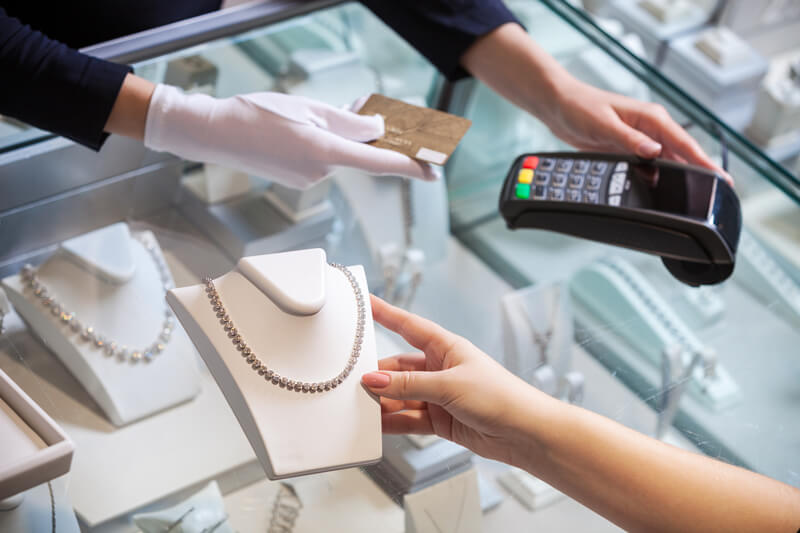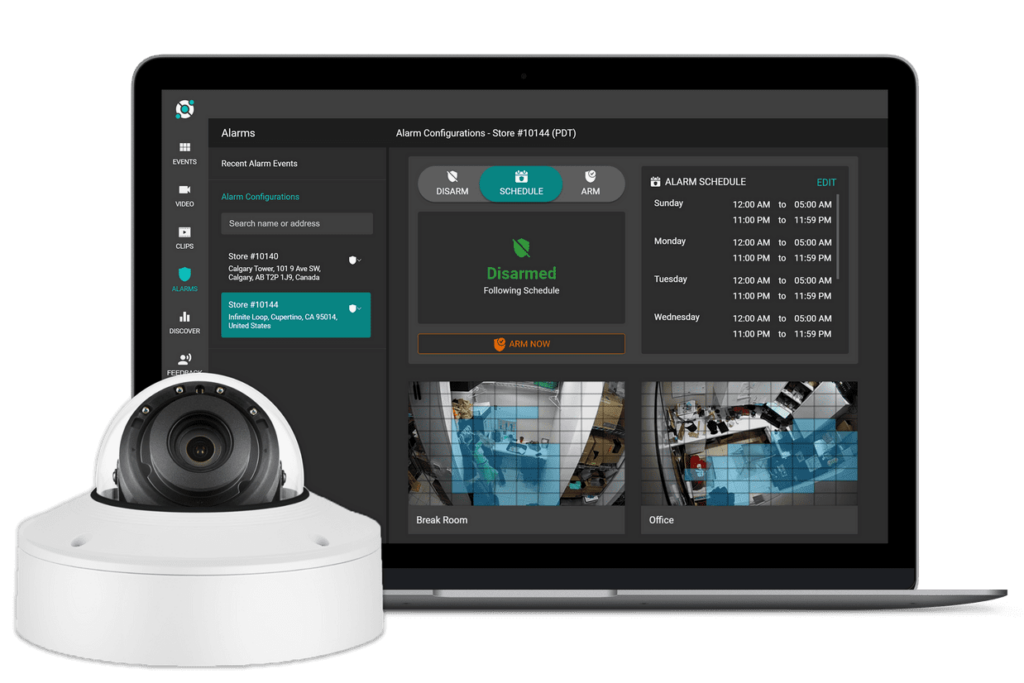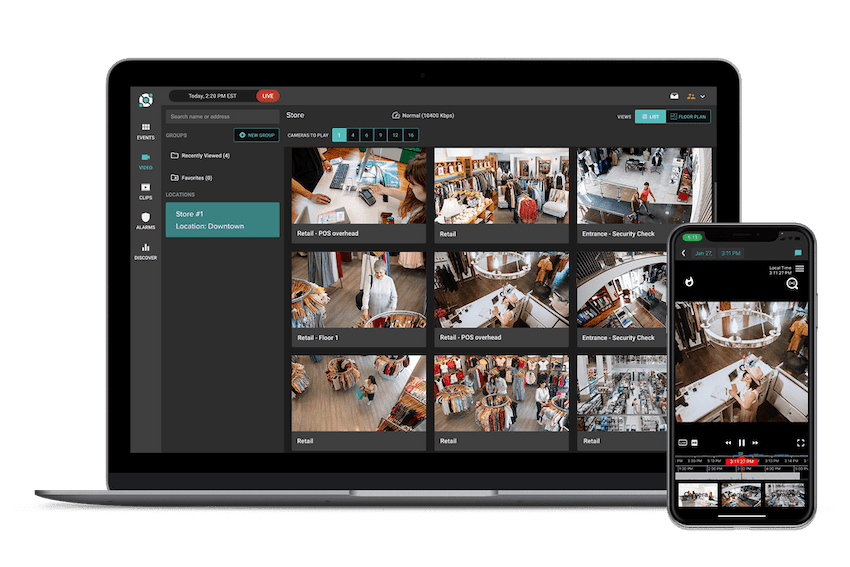Table of Contents
Table of Contents
Retail statistics show that crime has been on the rise the last few years. One retail segment that isn’t getting enough attention is jewelry. The fact is that jewelry stores carry light and expensive merchandise, which makes them particularly vulnerable to theft, and popular targets for armed robberies as well. Here are 25 jewelry store security tips to help keep your business, customers, and employees safe.
What are the threats to jewelry stores?
Jewelry stores, with their high-value items, are attractive targets for various types of threats. These threats range from organized retail crime to internal theft issues. Understanding these risks is crucial for implementing effective security measures. By identifying the specific types of threats they face, jewelry stores can tailor their security strategies to protect their assets, staff, and customers effectively.
- Organized retail crime (ORC): ORC involves professional criminals who steal merchandise in large quantities to resell. Jewelry stores are particularly vulnerable due to the high resale value of their items. These crimes are often sophisticated and may involve both internal and external actors.
- Discount abuse: This occurs when promotions or discounts are exploited inappropriately, often by employees or through fraudulent means. It can lead to significant revenue loss over time.
- Health and safety violations: These include non-compliance with safety regulations, leading to hazards for both staff and customers. In a jewelry store, this might involve unsafe display setups or inadequate emergency procedures.
- Internal theft: Employees stealing merchandise or funds. This type of theft can be particularly damaging as it involves breach of trust and can be challenging to detect.
- External theft: Shoplifting, smash-and-grab robberies, and burglary are common forms of external theft. These acts can result in significant loss of merchandise and can also be violent, posing a threat to staff and customers.
- Poor cash handling procedures: Inefficient or insecure cash handling can lead to theft or loss. This includes not having secure registers, inadequate tracking of transactions, and lack of regular audits.
- Cybersecurity threats: With the increasing use of digital systems, jewelry stores face risks like hacking, phishing, and other cyber-attacks, leading to data breaches or financial loss.
- Supply chain disruptions: Problems with suppliers can affect inventory, leading to stock shortages or excess, impacting revenue and customer satisfaction.
- Counterfeiting: The sale of counterfeit jewelry can affect market prices and brand reputation, and inadvertently purchasing counterfeit goods can lead to financial losses.
- Employee fraud: These activities include manipulating sales records, credit card fraud, or collusion with external thieves. Such actions not only result in financial loss but also damage the store’s credibility.
By being aware of and addressing these threats, jewelry stores can bolster their security measures, ensuring the safety of their merchandise, employees, and customers. Solink’s advanced video monitoring and analytics can play a crucial role in identifying and mitigating these risks.
25 jewelry store security tips
Here is a list of 25 jewelry store security measures that can reduce your risk of theft, as well as keep you safe from other potential losses. While not every tip can be implemented today, we’re sure you’ll find some easy wins and the short term and big ROI in the long term.
Access control
Access control is a fundamental aspect of security in jewelry stores. It involves managing who can enter and exit the premises and under what circumstances. This category focuses on ensuring that only authorized personnel have access to sensitive areas, thereby reducing the risk of theft, unauthorized entry, and other security breaches. By implementing robust access control measures, jewelry stores can significantly enhance their overall security posture.
Effective access control is not just about locking doors; it’s about integrating advanced technologies and protocols to monitor and manage access points. It ensures that the store is secure during vulnerable times, such as opening and closing hours, and that any access to the store is recorded on video and can be reviewed if needed.
Connecting Solink to your cloud-based access control system captures video of every access event. This integration offers a dual advantage: it strengthens access control and enhances security. By syncing video footage with access logs, you gain a comprehensive view of who accesses your store and when, allowing for easier investigation of any incidents. Solink integrates with Brivo to give you better control over who is entering your jewelry store.

2. Controlled access
Controlled access is essential for maintaining security before and after business hours. By keeping doors locked during non-operating hours, you prevent unauthorized entry. This practice should be a standard part of your security routine, ensuring that access to your store is strictly regulated. From preventing unauthorized backdoor entry at night to keeping products in the stockroom safe, controlled access is all about layers of security.
3. Two-person policy for opening and closing
Implementing a two-person policy for opening and closing the store is a smart safety measure. This approach ensures that no employee is alone during these vulnerable times, reducing the risk of theft or harm. It creates a buddy system that adds an extra layer of security and peace of mind for staff members.
Cybersecurity
In the digital age, cybersecurity is crucial for businesses, including jewelry stores. As stores increasingly rely on digital systems for transactions, inventory management, and communication, protecting these systems from cyber threats becomes paramount. Cybersecurity measures are designed to safeguard sensitive data, prevent digital theft, and protect against cyber attacks that could disrupt business operations.
Good cybersecurity practices involve securing Internet connections, protecting customer data, and ensuring that all digital transactions are safe. This not only helps in preventing financial losses but also in maintaining customer trust and the store’s reputation.
4. Online discretion
Exercising discretion with what is posted online, especially photos that reveal store layout or displays, is important for security. This prevents potential thieves from planning thefts based on your store’s layout.
5. Cybersecurity measures
Implementing comprehensive cybersecurity measures is vital in protecting your store’s digital assets. This includes regularly updating software, using strong passwords (or password managers), 2FA, and training staff on cybersecurity best practices. These measures help in safeguarding sensitive information against cyber attacks.
6. Encrypt your Internet connection
Encrypting your Internet connection is a critical step in protecting your business from cyber threats. This prevents unauthorized access to your network, securing both business and customer data. Use secure Wi-Fi protocols and consider a VPN to enhance security.
Fraud and theft prevention
Fraud and theft prevention are key components of a comprehensive security strategy for jewelry stores. These measures are designed to deter potential thieves, identify fraudulent activities, and protect valuable merchandise. Implementing these tips not only helps in minimizing financial losses but also contributes to creating a safe and secure shopping environment for customers.
The importance of fraud and theft prevention cannot be overstated in the high-value context of a jewelry store. These strategies involve both proactive customer engagement and strategic merchandise management to minimize opportunities for theft and fraud.
7. Customer engagement
Engaging with every customer helps in deterring theft. It sends a message that staff are attentive and aware, making it difficult for potential thieves to act. This practice also enhances customer service and the overall shopping experience.
8. Discreet alert system
Having a discreet alert system allows staff to communicate suspicious activity without causing alarm. This can be a code word or phrase that is understood among staff to signal caution, or a panic alarm. It’s an effective way to manage potential threats while maintaining a calm store environment.
9. Fraud prevention
Fraud prevention is crucial in protecting your business’s financial integrity. This includes verifying the identity of customers during transactions and being vigilant against common fraud tactics. Training staff to recognize and respond to fraud attempts is key.

10. Incident logbook
Maintaining an incident logbook helps in documenting and tracking suspicious activities. This record can be invaluable for identifying patterns of behavior that may indicate potential threats. It also serves as a reference for law enforcement if needed. It can also improve your case management.
11. Show one item at a time
Showing only one item at a time to customers minimizes the risk of grab-and-run thefts. This practice keeps high-value items secure and under control. It’s a simple yet effective way to prevent quick thefts.
12. Spread high-value merchandise across your showroom
Spreading high-value items across your showroom prevents the concentration of valuables in one spot, making it harder for thieves to target specific areas. This also encourages customers to explore the store more fully.
13. Strategic merchandise placement
Strategic placement of merchandise is about more than just aesthetics. It’s a security measure that involves positioning items in a way that minimizes theft risks. Place high-value items in secure, well-surveilled areas, and consider traffic flow in the store layout.
Physical security
Physical security is the cornerstone of protecting a jewelry store. It encompasses the measures taken to secure the premises, protect merchandise, and ensure the safety of both customers and staff. This category includes robust security systems, secure showcases, and procedures for handling high-traffic periods or special events.
The effectiveness of physical security measures is often the first line of defense against theft and burglary. Ensuring that these measures are robust, well-maintained, and regularly updated is crucial for the overall security of the store.
Verifying every alarm signal with live video ensures that any security breaches are promptly addressed. This reduces the likelihood of false alarms and ensures a quick response in case of an actual threat.
15. Physical security audit
Regular physical security audits help in identifying and addressing potential vulnerabilities. This might include assessing entry points, window security, and the condition of locks and alarms. Regular reviews ensure your physical security measures are up to date and effective.

16. Robust display cases
Using display cases that are strong enough to withstand smash-and-grab attempts is vital. These cases protect your merchandise as part of your loss prevention system while still allowing it to be displayed attractively. Investing in quality showcases is a crucial part of your store’s physical security.
17. Seasonal security enhancement
Enhancing security during busy seasons or special events involves additional measures like hiring uniformed officers or increasing staff presence. These steps help in managing larger crowds and deterring potential thefts during peak times.
Solink’s video alarms monitoring service enhances security response times with video verification. This service allows for quick assessment of alarms, ensuring that real threats are addressed promptly and false alarms are minimized.

Security and Monitoring
Security and monitoring are vital for maintaining security in a jewelry store. These systems provide real-time oversight of the store’s interior and exterior, helping to deter theft and document any suspicious activities. The use of advanced video monitoring technologies, like those offered by Solink, enhances the ability to monitor and respond to security incidents.
Effective security and monitoring involve not just the installation of cameras but also regular review and analysis of the footage. This helps in identifying potential security threats and aids in the investigation of incidents.
19. Frequent security review
Regularly reviewing security footage is crucial for identifying suspicious activities that may have been missed. This proactive approach helps in early detection of potential threats and enhances overall security.
20. Use Solink’s integrated video security
Integrating Solink’s cloud video management system offers advanced monitoring capabilities. This integration provides real-time insights and can be linked with other security systems for a comprehensive security solution. Solink integrates with hundreds of systems to improve security, including many point of sale (POS) systems.
Utilizing your security cameras for real-time remote video monitoring gives senior management the ability to conduct more regular security audits. They can quickly scroll through dozens of storefronts in minutes to make sure everyone is following security best practices.

Transaction and Inventory Management
Transaction and inventory management are critical for the smooth operation and security of a jewelry store. Proper management ensures accurate tracking of merchandise, prevents inventory shrinkage, and helps in identifying discrepancies that may indicate theft or fraud. This category focuses on practices that ensure the integrity of transactions and the safekeeping of inventory.
Effective transaction and inventory management require meticulous record-keeping, regular audits, and the implementation of procedures that minimize the risk of theft or fraud. This is essential not only for inventory control but also for maintaining customer trust and financial integrity.
22. Communication and collaboration
Sharing information about suspicious incidents with staff and local law enforcement is key to preventing future incidents. This collaboration helps in creating a network of vigilance and enhances store security.
23. Improve cash handling procedures
Improving cash handling procedures minimizes the risk of internal theft and errors. This includes using secure registers, conducting regular reconciliations, and training staff in proper cash management practices.
24. Local crime awareness
Many businesses are facing an increase in crime, especially organized retail crime (ORC). One form of ORC is the “flash mob burglary” where dozens of people swarm into the same retail store and take whatever they can. Knowing whether this threat exists locally can protect your business and employees.
25. Secure overnight storage
Keeping as much merchandise as possible in a safe or vault overnight is a fundamental security practice. This reduces the risk of theft during non-business hours and ensures that your valuable items are protected.
Use Solink to improve your jewelry store security
Jewelry stores are high-value targets for thieves and other criminals. With the recent rise in retail crime, it is time for store managers to review their security procedures.
Solink brings all of your varied systems together, creating a security mesh to protect your jewelry stores. From better access control to better oversight of every transaction, Solink can help protect your jewelry store from theft, liability, and other forms of loss.
To see how Solink can help secure your jewelry store, sign up for a demo today.

Solink stands at the forefront of security solutions, excelling in loss prevention and asset protection for businesses. Our content is rich in industry expertise and crafted to provide actionable insights and innovative strategies. We empower businesses to enhance their security systems, optimize operations, and protect their assets more effectively. Discover how our advanced cloud video management system can transform your security approach.
